-
Topics covered
- Software process models
- Process activities
- Coping with change
- Process improvement
Software processes
- A structured set of activities required to develop a software system.
- A software process model is an abstract representation of a process.
- It presents a description of a process from some particular perspective.
- Many different software processes but all involve:
- Specification – defining what the system should do;
- Design and implementation – defining the organization of the system and implementing the system;
- Validation – checking that it does what the customer wants;
- Evolution – changing the system in response to changing customer needs.
Software process descriptions
- When we describe and discuss processes, we usually talk about the activities in these processes and the ordering of these activities.
- Some examples of these processes:
- specifying a data model,
- designing a user interface, etc.
- Process descriptions may also include:
- Products, which are the outcomes of a process activity;
- Roles, which reflect the responsibilities of the people involved in the process;
- Pre - and post-conditions
- which are statements that are true before and after a process activity has been enacted or a product produced.
Plan-driven and agile processes
- Plan-driven processes are processes where all of the process activities are planned in advance and progress is measured against this plan.
- In agile processes, planning is incremental and it is easier to change the process to reflect changing customer requirements.
- In practice, most practical processes include elements of both plan-driven and agile approaches.
- There are no right or wrong in software processes. It depends on what type of project, resource and budget etc. to decide.
-
Software process models
-
Software process models
- 📷 The waterfall model
- ● Plan-driven model. Separate and distinct phases of specification and development.
- Incremental development
- ● Specification, development and validation are interleaved. May be plan-driven or agile.
- Integration and configuration
- ● The system is assembled from existing configurable components. May be plan-driven or agile.
- In practice, most large systems are developed using a process that incorporates elements from all of these models.
Waterfall model phases
- There are separate identified phases in the waterfall model:
- ● Requirements analysis and definition
- ● System and software design
- ● Implementation and unit testing
- ● Integration and system testing
- ● Operation and maintenance
Drawback of the waterfall model
- The main drawback of the waterfall model is the difficulty of accommodating change after the process is underway.
- In principle, a phase has to be complete before moving onto the next phase.
Waterfall model problems
- Inflexible partitioning of the project into distinct stages makes it difficult to respond to changing customer requirements.
- ● Therefore, this model is only appropriate when the requirements are well-understood and changes will be fairly limited during the design process.
- ● Few business systems have stable requirements.
- The waterfall model is mostly used for large systems engineering projects where a system is developed at several sites.
- ● In those circumstances, the plan-driven nature of the waterfall model helps coordinate the work.
X- Plan-driven model. Separate and distinct phases of specification and development.

-
Incremental development
- 📷 Specification, development and validation are interleaved.
Incremental development benefits
- The cost of accommodating changing customer requirements is reduced.
- ● The amount of analysis and documentation that has to be redone is much less than is required with the waterfall model.
- It is easier to get customer feedback on the development work that has been done.
- ● Customers can comment on demonstrations of the software and see how much has been implemented.
- More rapid delivery and deployment of useful software to the customer is possible.
- ● Customers are able to use and gain value from the software earlier than is possible with a waterfall process.
Incremental development problems
- The process is not visible.
- ● Managers need regular deliverables to measure progress. If systems are developed quickly, it is not cost-effective to produce documents that reflect every version of the system.
- System structure tends to degrade as new increments are added.
- ● Unless time and money is spent on refactoring to improve the software, regular change tends to corrupt its structure.
- ● Incorporating further software changes becomes increasingly difficult and costly.
X
-
Integration and configuration
- Based on software reuse where systems are integrated from existing components or application systems (sometimes called COTS - Commercial-off-the-shelf) systems).
- Reused elements may be configured to adapt their behaviour and functionality to a user’s requirements
- Reuse is now the standard approach for building many types of business system
- ● Reuse covered in more depth in week 11: Chapter 15.
Types of reusable software
- Stand-alone application systems (sometimes called COTS) that are configured for use in a particular environment.
- Collections of objects that are developed as a package to be integrated with a component framework such as .NET or J2EE.
- Web services that are developed according to service standards and which are available for remote invocation.
📷 Reuse-oriented software engineeringKey process stages
- Requirements specification
- Software discovery and evaluation
- Requirements refinement
- Application system configuration
- Component adaptation and integration
Advantages and disadvantages
- Reduced costs and risks as less software is developed from scratch
- Faster delivery and deployment of system
- But requirements compromises are inevitable so system may not meet real needs of users
- Loss of control over evolution of reused system elements
X
-
Process activities
-
- Real software processes are inter-leaved sequences of technical, collaborative and managerial activities with the overall goal of specifying, designing, implementing and testing a software system.
Four Basic Process Activities
- The four basic process activities:
- ● specification,
- ● development,
- ● validation and
- ● evolution
- ● They are organized differently in different development processes.
- For example, in the waterfall model, they are organized in sequence, whereas in incremental development they are interleaved.
📷 The requirements engineering processSoftware specification
- The process of establishing what services are required and the constraints on the system’s operation and development.
- Requirements engineering process
- ● Requirements elicitation and analysis
- ○ What do the system stakeholders require or expect from the system?
- ● Requirements specification
- ○ Defining the requirements in detail
- ● Requirements validation
- ○ Checking the validity of the requirements
- ○ Requirements engineering covered in more depth in week 4: Chapter 4.
Software design and implementation
- The process of converting the system specification into an executable system.
- Software design
- ● Design a software structure that realises the specification;
- Implementation
- ● Translate this structure into an executable program;
- The activities of design and implementation are closely related and may be inter-leaved.
X
-
📷 A general model of the design process
Design activities
- Architectural design, where you identify the overall structure of the system, the principal components (subsystems or modules), their relationships and how they are distributed.
- Database design, where you design the system data structures and how these are to be represented in a database.
- Interface design, where you define the interfaces between system components.
- Component selection and design, where you search for reusable components. If unavailable, you design how it will operate.
System implementation
- The software is implemented either by developing a program or programs or by configuring an application system.
- Design and implementation are interleaved activities for most types of software system.
- Programming is an individual activity with no standard process.
- Debugging is the activity of finding program faults and correcting these faults.
- Design and implementation covered in more depth in week 7: Chapter 7.
Software validation
- Verification and validation (V & V) is intended to show that a system conforms to its specification and meets the requirements of the system customer.
- Involves checking and review processes and system testing.
- System testing involves executing the system with test cases that are derived from the specification of the real data to be processed by the system.
- Testing is the most commonly used V & V activity.
Testing stages
📷 Stages of testing- Component testing
- ● Individual components are tested independently;
- ● Components may be functions or objects or coherent groupings of these entities.
- System testing
- ● Testing of the system as a whole. Testing of emergent properties is particularly important.
- Customer testing
- ● Testing with customer data to check that the system meets the customer’s needs.
- ● Software Testing Reuse covered in more depth in week 8: Chapter 8.
📷 Testing phases in a plan-driven software process (V-model)X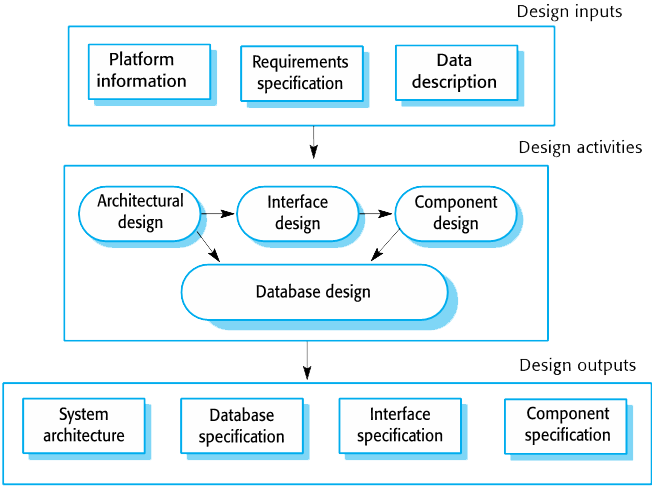 X
X X
X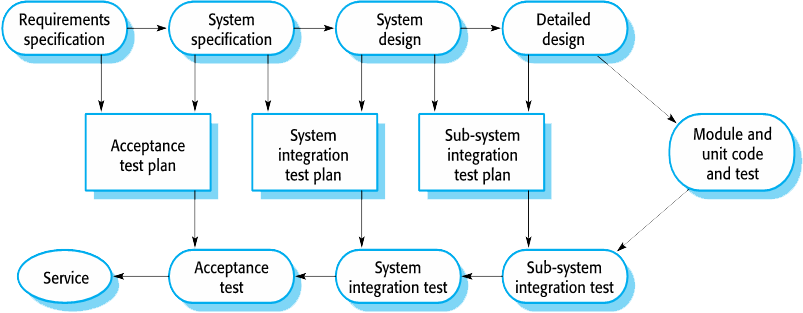
-
Software evolution
- Software is inherently flexible and can change.
- As requirements change through changing business circumstances, the software that supports the business must also evolve and change.
- Although there has been a demarcation between development and evolution (maintenance) this is increasingly irrelevant as fewer and fewer systems are completely new.
- Software evolution covered in more depth in week 9: Chapter 9.
System evolution

-
Coping with change
-
Coping with change
- Change is inevitable in all large software projects.
- ● Business changes lead to new and changed system requirements
- ● New technologies open up new possibilities for improving implementations
- ● Changing platforms require application changes
- Change leads to rework so the costs of change include both rework (e.g. re-analysing requirements) as well as the costs of implementing new functionality
Reducing the costs of rework
- Change anticipation, where the software process includes activities that can anticipate possible changes before significant rework is required.
- ● For example, a prototype system may be developed to show some key features of the system to customers.
- Change tolerance, where the process is designed so that changes can be accommodated at relatively low cost.
- ● This normally involves some form of incremental development. Proposed changes may be implemented in increments that have not yet been developed.
- ● If this is impossible, then only a single increment (a small part of the system) may have be altered to incorporate the change.
Coping with changing requirements
- System prototyping,
- ● where a version of the system or part of the system is developed quickly to check the customer’s requirements and the feasibility of design decisions.
- ● This approach supports change anticipation.
- Incremental delivery,
- ● where system increments are delivered to the customer for comment and experimentation.
- ● This supports both change avoidance and change tolerance.
-
Software prototyping
- A prototype is an initial version of a system used to demonstrate concepts and try out design options.
- A prototype can be used in:
- ● The requirements engineering process to help with requirements elicitation and validation;
- ● In design processes to explore options and develop a UI design;
- ● In the testing process to run back-to-back tests.
Benefits of prototyping
- Improved system usability.
- A closer match to users’ real needs.
- Improved design quality.
- Improved maintainability.
- Reduced development effort.
Prototype development
📷 The process of prototype development- May be based on rapid prototyping languages or tools
- May involve leaving out functionality
- ● Prototype should focus on areas of the product that are not well-understood;
- ● Error checking and recovery may not be included in the prototype;
- ● Focus on functional rather than non-functional requirements such as reliability and security
Throw-away prototypes
- Prototypes should be discarded after development as they are not a good basis for a production system:
- ● It may be impossible to tune the system to meet non-functional requirements;
- ● Prototypes are normally undocumented;
- ● The prototype structure is usually degraded through rapid change;
- ● The prototype probably will not meet normal organisational quality standards.
X
-
Incremental delivery
- Rather than deliver the system as a single delivery, the development and delivery is broken down into increments with each increment delivering part of the required functionality.
- User requirements are prioritised and the highest priority requirements are included in early increments.
- Once the development of an increment is started, the requirements are frozen though requirements for later increments can continue to evolve.
Incremental development
- Develop the system in increments and evaluate each increment before proceeding to the development of the next increment;
- Normal approach used in agile methods;
- Evaluation done by user/customer proxy.
Incremental delivery
- Deploy an increment for use by end-users;
- More realistic evaluation about practical use of software;
- Difficult to implement for replacement systems as increments have less functionality than the system being replaced.
📷 Incremental delivery diagramIncremental delivery advantages
- Customer value can be delivered with each increment so system functionality is available earlier.
- Early increments act as a prototype to help elicit requirements for later increments.
- Lower risk of overall project failure.
- The highest priority system services tend to receive the most testing.
Incremental delivery problems
- Most systems require a set of basic facilities that are used by different parts of the system.
- ● As requirements are not defined in detail until an increment is to be implemented, it can be hard to identify common facilities that are needed by all increments.
- The essence of iterative processes is that the specification is developed in conjunction with the software.
- ● However, this conflicts with the procurement model of many organizations, where the complete system specification is part of the system development contract.
X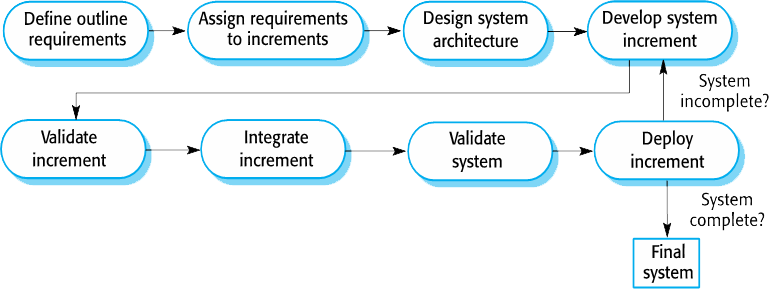
-
Process improvement
-
Process improvement
- Many software companies have turned to software process improvement as a way of enhancing the quality of their software, reducing costs or accelerating their development processes.
- Process improvement means understanding existing processes and changing these processes to increase product quality and/or reduce costs and development time.
Approaches to improvement
- The process maturity approach, which focuses on improving process and project management and introducing good software engineering practice.
- ● The level of process maturity reflects the extent to which good technical and management practice has been adopted in organizational software development processes.
- The agile approach, which focuses on iterative development and the reduction of overheads in the software process.
- ● The primary characteristics of agile methods are rapid delivery of functionality and responsiveness to changing customer requirements.
📷 The process improvement cycleProcess improvement activities
- Process measurement
- ● You measure one or more attributes of the software process or product.
- ● These measurements forms a baseline that helps you decide if process improvements have been effective.
- Process analysis
- ● The current process is assessed, and process weaknesses and bottlenecks are identified.
- ● Process models (sometimes called process maps) that describe the process may be developed.
- Process change
- ● Process changes are proposed to address some of the identified process weaknesses.
- ● These are introduced and the cycle resumes to collect data about the effectiveness of the changes.
The SEI capability maturity model
- Initial
- ● Essentially uncontrolled
- Repeatable
- ● Product management procedures defined and used
- Defined
- ● Process management procedures and strategies defined and used
- Managed
- ● Quality management strategies defined and used
- Optimising
- ● Process improvement strategies defined and used
📷 Capability maturity levelsX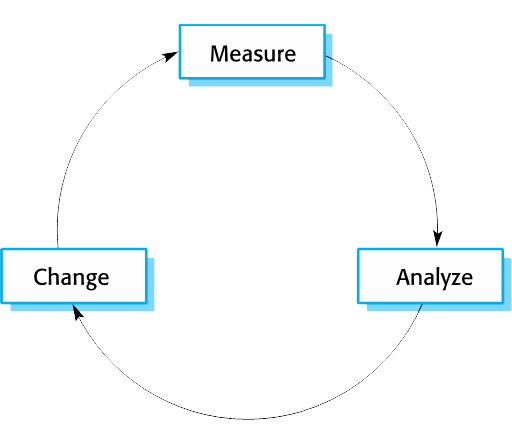 X
X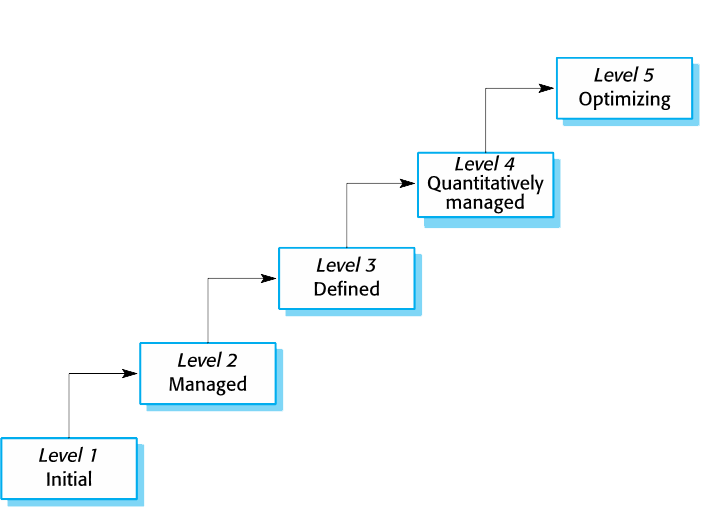
-
Key points
- Software processes are the activities involved in producing a software system. Software process models are abstract representations of these processes.
- General process models describe the organization of software processes.
- ● Examples of these general models include the ‘waterfall’ model, incremental development, and reuse-oriented development.
- Requirements engineering is the process of developing a software specification.
- Design and implementation processes are concerned with transforming a requirements specification into an executable software system.
- Software validation is the process of checking that the system conforms to its specification and that it meets the real needs of the users of the system.
- Software evolution takes place when you change existing software systems to meet new requirements. The software must evolve to remain useful.
- Processes should include activities such as prototyping and incremental delivery to cope with change.
- Processes may be structured for iterative development and delivery so that changes may be made without disrupting the system as a whole.
- The principal approaches to process improvement are agile approaches, geared to reducing process overheads, and maturity-based approaches based on better process management and the use of good software engineering practice.
- The SEI process maturity framework identifies maturity levels that essentially correspond to the use of good software engineering practice.
-
Glossary
ADEHIOPSW
A
ACM
- The Association for Computing Machinery (ACM) is an international learned society for computing.
- data source: https://en.wikipedia.org/wiki/Association_for_Computing_Machinery
AJAX
- Ajax stands for Asynchronous Javascript And Xml. AJAX is about updating parts of a web page, without reloading the whole page.
- data source: http://www.w3schools.com/ajax/ajax_intro.asp
Return to TopD
Dependability
- The dependability of a system is an aggregate property that takes into account the system's safety, reliability, avaiability, security and other attributes. The dependability of a system reflects the extent to which it can be trusted by its users.
- data source: Sommerville I. 2016 "Software Engineering" 10th Edition. Pearson Pp.762.
Return to TopE
Embedded system
- A software system that is embedded in a hardware device (e.g. the software system in a mobile phone). Embedded systems are usually real-time systems and so have to respond in a timely way to events occurring in their environment.
- data source: Sommerville I. 2016 "Software Engineering" 10th Edition. Pearson Pp.762.
Return to TopH
HTML5
- HTML5 is a markup language for describing web documents (web pages). HTML stands for HyperText Markup Language; HTML5 is supported in all modern browsers.
I
IEEE
- The Institute of Electrical and Electronics Engineers (IEEE, pronounced I triple E) is a professional association with its corporate office in New York City and its operations center in Piscataway, New Jersey. It was formed in 1963 from the amalgamation of the American Institute of Electrical Engineers and the Institute of Radio Engineers. Today, it is the world's largest association of technical professionals with more than 400,000 members in chapters around the world. Its objectives are the educational and technical advancement of electrical and electronic engineering, telecommunications, computer engineering and allied disciplines.
- data source: https://en.wikipedia.org/wiki/Institute_of_Electrical_and_Electronics_Engineers
Information system
- An informtion system is a system of communication between people. Information system are systems involved in the gathering, processing, distrution and use of information.
- data source: Beynon-Davies, P. 2000, "Information systems: An introduction to informatics in organisations",2nd Edition, Palgrave. Pp.583.
Internet
- A set of interconnected computer newtworks distributed around the globe
- data source: Beynon-Davies, P. 2000, "Information systems: An introduction to informatics in organisations",2nd Edition, Palgrave. Pp.584.
Return to TopO
Open source
- An approach to software development where the fundamental abstractions in the system are independent objects. The same type of abstraction is used during specfication, design and development.
- data source: Sommerville I. 2016 "Software Engineering" 10th Edition. Pearson Pp.766
Return to TopP
Project management
- The process of planning for, organising and controlling projects.
- data source: Beynon-Davies, P. 2000, "Information systems: An introduction to informatics in organisations",2nd Edition, Palgrave. Pp.589.
Return to TopS
Security
- The ability of a system to protect itself against accidental or deliberate intrusion. Security includes confidentiality, integrity and avaiablility.
- data source: Sommerville I. 2012 "Software Engineering" 10th Edition. Pearson Pp.771.
Software development
- often used as another name for the software process; originally coined to refer to the watherfall model of the software process.
- data source: Sommerville I. 2016 "Software Engineering" 10th Edition. Pearson Pp.771.
Return to TopW
waterfall model
- A software process activities of specification development, validation, and evolution and represents them as separated process phases such as requriements specification, software design, implementation and testing.
- data source: Sommerville I. 2016"Software Engineering" 10th Edition. Pearson Pp.45.
Web service
- An independent software component that can be accessed through the Internet using standard protocols. It is completely self-contained without external dependencies. XML-based standards such as SOAP (Standard Object Access Protocol) for web service information exchange, and WSDL (Web Service Definition Language), for the definition of web service interfaces, have been developed. However, the REST approach may also be used for web service implementation.
- data source: Sommerville I. 2016 "Software Engineering" 10th Edition. Pearson Pp.774.
Wilderness weather system
- A system to collect data about the weather conditions in remote areas.
- data source: Sommerville I. 2016 "Software Engineering" 10th Edition. Pearson Pp.775.
WWW
- World Wide Web. A set of standards for hypermedia documentation. It now has become synonymous with the Internet.
- data source: Beynon-Davies, P. 2000, "Information systems: An introduction to informatics in organisations",2nd Edition, Palgrave. Pp.595.
Return to Top